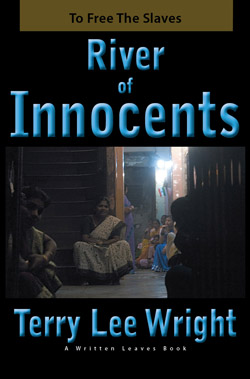Reading Group Prompts
0 Comments
Welcome, and thank you for choosing River of Innocents for your reading group. The following are a few discussion prompts to get you started. Note that they are written assuming that you have finished the book, and contain spoilers for later chapters.
- Why is Lule still a slave?
- Over the course of the novel, how did the presence or absence of her girls–her family–affect Majlinda’s behavior and spirit?
- Majlinda begins the novel unwilling to blame her father for his drinking. How does this compare to the way she feels about traffickers at the end of the story?
- Where does Majlinda get her stubborn streak? Her sense of forgiveness?
- If Majlinda’s mother hadn’t died, what would have happened to Majlinda? Would she have been a slave, or would another have taken her place?
- At the end, Majlinda could have accepted one more rape–one after thousands–to give her girls time to free her. Why didn’t she? Do you think it was a conscious decision?
- In the real world, slaves tend to die less dramatically than Majlinda did, and for less reason. A girl like Majlinda might walk into a room one day and be shot in the head, and the story would end there. Slaves are disposable. Why didn’t Majlinda die that simply?
- Why is Murat so concerned about being clean?
- Why does he make his victims thank him?
- Why is the scene where he makes them thank him not depicted for the reader?
- How many actual rapes did we see in the course of the book? Why did we see those in particular, and in what ways were they different from each other?
- Arlinda’s “Gian” read poetry to her: Petrarchan poems about unrequieted love. What does unrequited love–or any love–mean in a place like the Factory? Why does Clarissa not see it the same way as Miriam or Arlinda?
- If we saw Clarissa at the end of the novel, would she still feel the same way about love? Why or why not?
- We don’t see the red of blood in Blood Christening at the beginning of the novel, but we do see it as we approach the end, firstly in the sanguinary red of the brick walls of the brothel in England. Why is that? What does red mean?
- The rolls of darkness and light change over the course of the novel. Where does this imagery start and how does it change?
- What major symbol in the story is blue, and what might blue mean? Are all blues equal, or is there something different about the blue of the sea, the sky, and Majlinda’s eyes?
- Majlinda’s story took her to four countries: Albania, Italy, Germany, and Great Britain. She makes two journeys by sea and one by land–is there any symbolic significance to which journeys are by sea?
- When a Gian pays for sex, if he doesn’t know he’s buying it from a slave, is it rape? Why or why not? If it is rape, who is the rapist–the Gian, or the slaver who rents the girl out? Or do they share responsibility?
- When the rich pay for sex through escort services or “high society” call-girls, what effect does that have on trafficking? When a state official in a position of power is engaging in prostitution where it is illegal, what effect does that have on the implementation of anti-trafficking laws?
- How do you think Madame Vaccaro might have first gotten involved in her business?
- What are some of Majlinda’s failures? What are her flaws? Would she agree with your assessment?
- Why does Majlinda recite the names of those who hear her? In the end, why does she add the names of traffickers to that list?
- When does the albino we see at the end become the Albino? (When does it become a proper noun?) Why does it happen then?
- The final brothel is a converted church. Why?
- Into what shape do the fake walls divide it? Why? What does it mean that they’re fake, and that the real ones are a sanguinary red and stronger?
- What is the significance of George Orwell’s 1984 at Madame Vaccaro’s?
- What is the significance of the fourth floor at the Whotehotel?
Leave a reply
You must be logged in to post a comment.

Bookmark with: